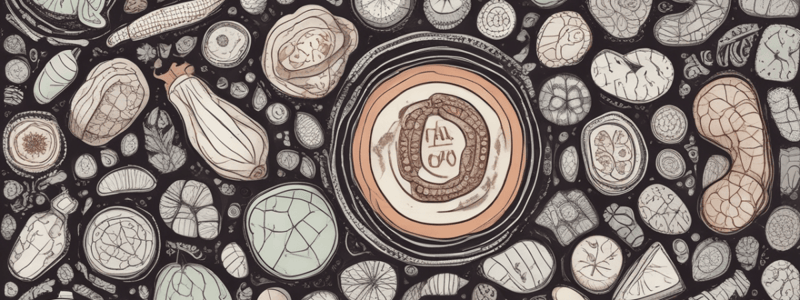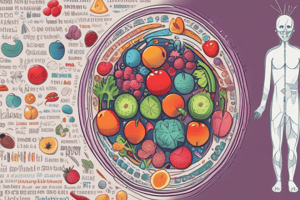Podcast
Questions and Answers
What is the primary form of maltose produced during starch digestion?
What is the primary form of maltose produced during starch digestion?
- Fructose
- Galactose
- β Maltose
- α Maltose (correct)
What is the difference between glucose and fructose in terms of their molecular structure?
What is the difference between glucose and fructose in terms of their molecular structure?
- Position of the carbonyl group (correct)
- Number of oxygen atoms
- Presence of a hydroxyl group
- Number of carbon atoms
What type of ring structure does glucose primarily exist as in solution?
What type of ring structure does glucose primarily exist as in solution?
- Furanose
- Pyranose (correct)
- Isopyranose
- Isofuranose
What are mannose and galactose in relation to glucose?
What are mannose and galactose in relation to glucose?
What is the configuration of the glycosidic bond in α maltose?
What is the configuration of the glycosidic bond in α maltose?
What is the configuration of the glycosidic bond in β maltose?
What is the configuration of the glycosidic bond in β maltose?
What is the primary cause of coma in unmanaged diabetes?
What is the primary cause of coma in unmanaged diabetes?
What is the main function of glucose in the body?
What is the main function of glucose in the body?
What is the empiric formula for many simpler carbohydrates?
What is the empiric formula for many simpler carbohydrates?
What determines whether a sugar belongs to the D or L series?
What determines whether a sugar belongs to the D or L series?
What is the classification of carbohydrates that are condensation products of three to ten monosaccharides?
What is the classification of carbohydrates that are condensation products of three to ten monosaccharides?
What is the result of high levels of glucose in the blood if not managed properly?
What is the result of high levels of glucose in the blood if not managed properly?
What is the type of bond that connects glucose units in amylopectin?
What is the type of bond that connects glucose units in amylopectin?
What is the function of glycoproteins in cell membranes?
What is the function of glycoproteins in cell membranes?
What is the nine-carbon sugar that is a constituent of glycoproteins and gangliosides?
What is the nine-carbon sugar that is a constituent of glycoproteins and gangliosides?
What type of bond is formed between glucose units in starch?
What type of bond is formed between glucose units in starch?
What is the term for the process of attaching oligosaccharide chains to proteins?
What is the term for the process of attaching oligosaccharide chains to proteins?
What is the storage form of glucose in animals?
What is the storage form of glucose in animals?
What is the type of sugar that is less common in nature?
What is the type of sugar that is less common in nature?
What is the function of sialic acids in glycoproteins and gangliosides?
What is the function of sialic acids in glycoproteins and gangliosides?
Flashcards are hidden until you start studying
Study Notes
Diabetes Complications
- High glucose levels in the blood can cause health problems over time if not managed properly
- Coma can result from both acidosis (due to ketone bodies production) and increased osmolality of extracellular fluid (mainly due to hyperglycemia and diuresis)
Carbohydrates
- Carbohydrates are the most abundant organic molecules in nature
- They have various functions, including providing dietary calories, acting as a storage form of energy, and serving as cell membrane components
- The empiric formula for simpler carbohydrates is (CH2O)n, hence the name "hydrate of carbon"
- Glucose is the most important carbohydrate
Classification of Carbohydrates
- Carbohydrates are classified as monosaccharides, disaccharides, oligosaccharides, or polysaccharides
- Monosaccharides cannot be hydrolyzed into simpler carbohydrates and are classified as trioses, tetroses, pentoses, hexoses, or heptoses
- Disaccharides are condensation products of two monosaccharide units (e.g. lactose, maltose, sucrose)
- Oligosaccharides are condensation products of three to ten monosaccharides (most are not digested by human enzymes)
- Polysaccharides are condensation products of more than ten monosaccharide units
Isomers and Epimers
- D and L isomerism: the orientation of the —H and —OH groups around the carbon atom adjacent to the terminal alcohol carbon determines whether the sugar belongs to the D or L series
- Most naturally occurring monosaccharides are D sugars, and the enzymes responsible for their metabolism are specific for this configuration
- Epimers: small differences in the structure of sugar molecules (e.g. glucose, mannose, and galactose)
Ring Structures of Monosaccharides
- Pyranose and furanose ring structures: similar to the ring structures of either pyran (six-membered ring) or furan (five-membered ring)
- Glucose in solution is mostly in the pyranose form (>99%)
Aldose-Ketose Isomerism
- Fructose and glucose have the same molecular formula (C6H12O6) but differ in the arrangement of atoms
- Glucose has an aldehyde group (at the end of the chain), while fructose has a ketone group (within the chain)
- This structural difference gives them distinct chemical and biological properties
Disaccharides
- α and β Maltose: two distinct forms of maltose, a disaccharide composed of two glucose molecules
- α Maltose: glycosidic bond between the two glucose molecules is formed with the alpha configuration
- β Maltose: glycosidic bond between the two glucose molecules is formed with the beta configuration
- Alpha maltose is the more common form found in nature and is the primary form produced during starch digestion
Polysaccharides
- Starch and glycogen are storage forms of glucose in plants and animals, respectively
- Amylose: a linear polymer of glucose units joined by alpha-1,4-glycosidic bonds
- Amylopectin: a branched polymer with both alpha-1,4 and alpha-1,6 glycosidic bonds
Glycoproteins
- Glycoproteins (also known as mucoproteins) are proteins containing branched or unbranched oligosaccharide chains including fucose
- They occur in cell membranes and many proteins are glycosylated
- Sialic acids (N- or O-acyl derivatives of neuraminic acid) are constituents of both glycoproteins and gangliosides
Studying That Suits You
Use AI to generate personalized quizzes and flashcards to suit your learning preferences.



